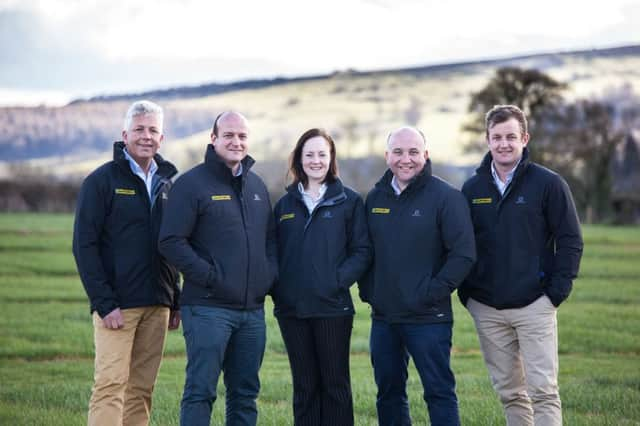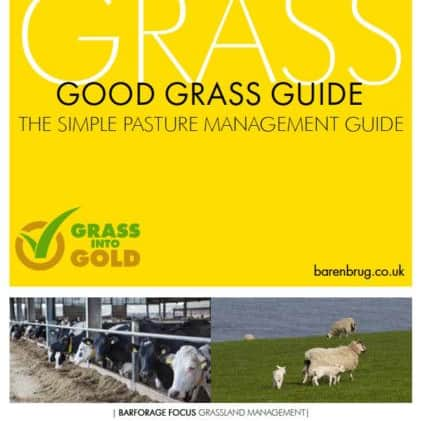Video and printed guide available to help farmers grade grass


The seven-minute film, produced by the agricultural team at Barenbrug UK, takes viewers through the company’s field indexing system – a simple means of benchmarking pasture status.
Shot in and around Barenbrug’s Cropvale Research and Trials site in Worcestershire, the short video includes practical pointers that can help farmers grade their grass and deal with the challenges typically faced at the five levels identified on the company’s sliding scale of pasture performance.
Advertisement
Hide AdAdvertisement
Hide AdTo support the release of its video, Barenbrug has also produced a hardback, ring-bound booklet called the Good Grass Guide. Available free of charge, the printed document tells farmers what to look for when scoring a field and gives practical advice on what to do to fix areas in need of work. There are photographs and information about productive grass species and common weeds. There is also space at the back of the guide for farmers to store notes and observations about their own pastures.


Barenbrug’s field indexing system is based on the ‘1 to 5 conditioning index’ used by many farmers to grade their stock. In Barenbrug’s model, grass is graded from level ‘5’ fields, which are considered highly productive, to swards that score a ‘1’ and are in need of immediate action. In the video, each index is introduced by one of Barenburg’s forage grass experts from a corresponding field.
Advice is provided on maintaining fields that are deemed healthy and profitable. There are hints for nurturing swards that are in need of work but still worthy of investment. There is also clear guidance for dealing with fields that are past their best and where starting from scratch would make best financial sense.
Mhairi Dawson, Research and Development Manager at Barenbrug, said: “The purpose of our field indexing system and our brand new video and guide is to help farmers easily identify what kind of fields they are working with. Armed with that information they can make informed decisions that will make their grass more profitable. 65% of agricultural land in the UK is grass – making it our nation’s biggest and most important crop.
Advertisement
Hide AdAdvertisement
Hide Ad“Grass is the base on which profitable farming is built and an asset that needs to be managed carefully. Most farms have fields at different stages of maturity. This variation can make it difficult to know which tasks to prioritise. Hopefully our indexing system, the footage in our film, and our hardback guide will show farmers the options available on a field by field basis – and what will work best to ultimately make grass more productive.”


Barenbrug’s field indexing system is based around the following principles:
Index 1: An index 1 field will have less than 25% sown, productive species left and any ryegrass remaining is likely to be of very poor quality. The gaps created by the disappearing ryegrass may have been filled up with broad leave weeds and weed grasses such as annual meadowgrass, yorkshire fog, bent grasses, chewing fescue and strong creeping red fescue. Fields with a classification of Index 1 are not nutritious, have no feed value and are therefore of no use to ruminant livestock. There is little point in putting any fertiliser on fields of this kind. The best course of action is to plough it up and start again with a re-seed.
Index 2: An index 2 field will have less than 40% sown, productive species with less than 10% clover (if sown), coupled with more than 40% weed content or gaps. The sward will be very open and any ryegrass left will be of very poor quality. Fields with an index 2 classification need urgent attention otherwise they will be a complete write-off. Options include burning off the existing sward before reseeding or overseeding.
Advertisement
Hide AdAdvertisement
Hide AdIndex 3: An index 3 field will have a total of 50-60% sown, productive species. It will also have approximately 40% weeds or gaps. Docks may also be present. At index 3, fields will respond well to remedial action and are ideally suited to a programme of overseeding that will extend pasture life. Before this occurs, docks should be removed. Clover could also be introduced to extend the life of the sward by a couple of years.
Index 4: An index 4 field will have a total of 60-70% of sown, productive species with ryegrass accounting for 60-70% of the plant population and clover making up the rest. With the clover adding nitrogen and protein content to help ensure high animal performance, fields with this classification should be good for the coming season. But they will have to be monitored and some overseeding of productive species could be required if penetration drops below 60%.
Index 5: An index 5 field will have at least 80% sown, productive species with clover making up around 30-40% of the plant population. There will be minimal weed content and gaps. Fields of this kind are healthy and profitable. This season, the only work required will be regular soil testing and soil structure monitoring.
To watch Barenbrug’s field indexing video and to sign up to receive a copy of the Good Grass Guide go to: www.barenbrug.co.uk/GoodGrassGuide.